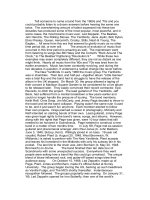9099 history of clothing
Bạn đang xem bản rút gọn của tài liệu. Xem và tải ngay bản đầy đủ của tài liệu tại đây (221.26 KB, 5 trang )
Ancient Egypt
The people of Ancient Egypt wore very few clothes. The women wore only a
straight, narrow skirt that hung from below the breasts to the feet. It was
suspended either from a single strap that crossed over one shoulder or from a
pair of straps, one over each shoulder. The garments were made of cotton or
linen and were usually white.
In ancient Egypt it was fashionable for both men and women to shave their
heads. For protection against the sun, the rich wore wigs and the poor wore
skullcaps. The women of ancient Egypt used a lot of cosmetics. They perfumed
their wigs and rubbed their bodies with fragrant oils. They decorated their eyes
with green and black kohl, and painted their lips red.
The ancient Egyptians embellished
clothing with elaborate costume
and women wore jewelry such as
bracelets, anklets, rings, and beaded necklaces. They
their jewelry many minerals including amethyst, garnet,
turquoise, and lapis lazuli, as well as copper, gold, and
the Egyptians were very superstitious, frequently their
good luck charms called amulets.
their usually plain
jewelry. Both men
earrings,
incorporated into
jasper, onyx,
shells. Because
jewelry contained
Crete
While the Egyptian empire was flourishing, the island of
the site of a well-developed civilization.
Women's clothing was designed to produce to give the
small waist and round, full hips. It consisted of a long, full,
and a small jacket. The skirt was brightly colored and
jacket covered only the back and arms.
Crete was also
effect of a very
multitiered skirt
patterned. The
Ancient Greece and Roman
Empire
In ancient Greece both men and
women wore the chiton, a draped
garment that was sewn up one
side and fastened at the shoulder
by a buckle. The woman's
garment fell to the ankles; the
man's usually reached only to the
knees. The chiton was made of
wool, cotton, linen, or silk.
Dress was one of the many
elements of Greek culture that
the Romans absorbed after they conquered Greece in the 2nd century BC. The Roman woman's
costume looked much like its Greek counterpart. The tunic, worn indoors, was based on the Greek
chiton.
The Byzantine Era
When the Roman Empire was divided in the 4th
century AD, Byzantium, later named Constantinople ,
became the capital of the eastern part. The dress worn
by the people of Byzantium bore traces of the influence
of Greece, Rome, and the Orient. Their drapery, derived
from Roman dress, displayed the rich fabrics of the East
heavy silks, damasks, and brocades.
Christianity also had an effect on Byzantine dress. In
keeping with the puritanical teachings of the Orthodox
Church, women of Byzantium concealed their bodies
entirely. They wore long, straight, sleeved tunics made
of silk or linen and bound at the waist with a belt that
was often heavily encrusted with jewels.
Middle Ages
During the late Middle Ages, the manner of dress made a complete break
with tradition. Women's dress at this period showed even more drastic
changes than ever before. Instead of all-enveloping garments that concealed
the shape of the figure, women began to constrict the waist by means of
stiffening in the bodice and to wear a low-cut neckline, or decolletage, that
revealed the throat and part of the breasts.
Women also changed their headdress. A veil was frilled to form an arch
around the face, or the hair was worn in two wide sections covered with
latticework attached to a fillet on top of the head. In the 1400s many elaborate
forms of headdress developed. There were horned headdresses and heartshaped headdresses.
The Renaissance
Patterned fabrics, usually velvets and brocades, were more
popular than materials of a single color from about 1480 to
1510. During this period of the Renaissance, Italian styles
dominated European fashion. Women's skirts became shorter,
and the long, trailing gown disappeared.
Women's clothing emphasized breadth. Skirts were
voluminous and pleated or were topped with a pleated apron.
The neckline was finished with a standing collar.
The 18th Century
The baroque tradition of dress reached its culmination in
France during the mid-18th century. The discovery of Chinese
art by the West led to a preoccupation with delicate
ornamentation and decoration. Chinese motifs, such as
bellflowers and canopies, appeared as decorative touches on
gowns. Soft pastel colors were borrowed from Chinese
paintings for use in men's and women's garments.
The dress worn by women was directed toward establishing a
conelike silhouette. Women's tightly corseted torsos terminated
in huge skirts that, though falling straight at the front and back,
were extended at the sides so that at the hem they were up to
12 feet across. These great skirts forced the ladies of the day to
pass sideways through most doorways. Men, as well as
women, used cosmetics heavily during the mid-18th century.
The effect was not a natural one, however, as complexions
were made to resemble porcelain. The face was stark white,
with lips of bright red.
By 1774, the year Louis XVI ascended the French throne, French fashions had literally reached
new heights. Women were wearing elaborate coiffures that were almost as tall as they were. The
hair was pulled up over pads and cushions, and false hair was added for even greater height.
Coiffures also utilized almost every kind of decoration imaginable from feathers to blown glass to
model ships.
The 19th Century
At the beginning of the 19th century, the passion for
ancient motifs in women's dress was on the wane. This
was partly a result of the ban on the importation of
Indian cotton muslin that Napoleon had imposed in an
effort to revive the French silk industry. With only heavier
materials available, clothing styles were forced to
change. The train again vanished, and short, puffed
sleeves appeared. Dresses usually worn with colorful
shawls. Skirts were shorter, leaving the feet exposed.
In the middle of the century there was a revival of 18thcentury French fashions, with undulating curves
determining the shape of women's garments. Women
took on the hourglass silhouette. The waist was
restricted by a corset, while seven or eight petticoats buoyed out the skirt. The fullness at the hem
was balanced by an exaggerated fullness at the breast. Later in the period, a crinoline, or hooped
underskirt, replaced the petticoats.
During the last quarter of the 19th century the crinoline, which had evolved from a round to an oval
shape, disappeared. It was replaced by the bustle, a pad or frame worn below the waist at the
back, over which the overskirt was draped. While the bustle was in vogue, the fullness of the skirt
was concentrated at the back, the front falling straight.
The 20th Century
In the first two decades of the century a popular
artistic point of view was that an object achieved
beauty by fulfilling its purpose.
This idea was incorporated into the design of women's
clothing at about the time of World War I. As dresses
and coats fell loosely about the body, the corset
practically disappeared. In the 1920s, the straight line
established the shape of dresses and hemlines began
to climb. By 1925, women's dresses had become
short, sleeveless tubes, belted at the hips. They
reached to the knee, revealing legs clad in lightcolored silk stockings. Although the length of the skirts
has since varied from mid-calf in 1947 to several
inches above the knee during the late 1960s, it has
remained relatively short since the 1920s.
Another innovation was the widespread adoption of
trousers by women. The bloomers of the preceding
century evolved into lounging pajamas during the
1920s and 1930s. From the 1930s, slacks were worn
for many leisure activities, and pantsuits became
widely acceptable for office and formal wear by 1970.
Answer the questions
Do you agree that it is important to be properly dressed? If you don’t want to feel cold or hot,
awkward or clumsy, overdressed or like "a poor relative", you have to choose your clothes very
carefully.
What would you wear to each of the following occasions. …
•
a new disco's first night?
•
an open-air rock-concert?
•
a summer afternoon near the river?
•
a quiet evening at home?
•
an entrance examination?
•
a barbecue in the country?
•
a formal party (your friend’s parents’ anniversary)?
Do clothes affect the way you react to other people? What can the clothes tell about a
person who wears them? complete the following statements using some of the words
given in the box below.
optimistic - hard-working - self-confident – creative - shy - organised – unfriendly tidy pessimistic - disorganised - friendly - untidy - adventurous – intelligent - conservative -fashionconscious - boring - lazy - stupid
1.
2.
3.
4.
5.
6.
7.
8.
9.
10.
People who never clean their shoes are ____________________
People who wear matching clothes are ____________________
People who always wear a suit and a tie are ________________
People who always wear dark clothes are __________________
People who wear bright colours are __________________
People who like to design their own clothes are ________________
People who never experiment with their clothes are ________________
People who wear crumpled clothes are ___________________
People who closely follow the fashion are _________________
People who prepare in the evening the clothes they will wear the next day are
Answer the following qustions about yourself.
•
Does fashion influence you when you choose clothes? Is it more important for you than
price, style, comfort, colour, etc.?
•
What is your attitude to the fashion currently popular in your country?
•
Do you wear jeans? If so, how often? If not, what sort of clothes do you like to wear?
•
Are/Were you allowed to wear what you like/d to school?
•
What clothes have you bought over the past year? How often have you worn your new
clothes?
Do you still like them? Have you been taking good care of them? What condition are they in now?
•
What image of yourself do you try to convey through your clothes?
•
Do you try to wear fashionable clothes every day?
•
Do you think the name on the label is more important than the clothes?
•
Is your friends’ or class-mates’ opinion about your clothes important to you?
•
Do you often borrow your friends’ clothes? Do you like to lend yours?









